Human MRS/MRI at Ultra-High Field
Oral
Spectroscopy & Non-Proton MR
Tuesday, 19 June 2018
| W03/04 |
16:15 - 18:15 |
Moderators: Anke Henning, Christopher Rodgers |
16:15
|
0618.
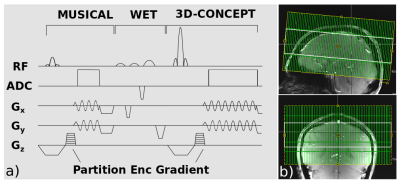 |
 Towards Full-Brain FID-MRSI At 7T With 3D Concentric Circle Readout Trajectories Towards Full-Brain FID-MRSI At 7T With 3D Concentric Circle Readout Trajectories
Lukas Hingerl, Bernhard Strasser, Philipp Moser, Michal Považan, Gilbert Hangel, Eva Heckova, Stephan Gruber, Siegfried Trattnig, Wolfgang Bogner
Proton magnetic resonance spectroscopic imaging is a powerful technique for clinical diagnosis; however, low spatial resolutions together with long scan times and SNR-per-time inefficiency prevent its wide spread application. The already proposed 2D-CONCEPT (concentric circle echo planar trajectories) sequence overcomes this issue by capitalizing most efficiently on the hardware constraints of the gradient system. The purpose of this abstract is to present first preliminary results of an extension to 3D-CONCEPT for full-brain 3D-FID-MRSI at 7T for a 64x64x31 matrix acquired within 23 minutes.
|
16:27
 |
0619.
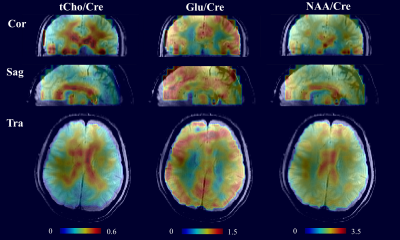 |
 Whole Brain High Resolution Metabolite Mapping Using 1H FID MRSI with Slice-wise B0 Shim Updating at 9.4T Whole Brain High Resolution Metabolite Mapping Using 1H FID MRSI with Slice-wise B0 Shim Updating at 9.4T
Sahar Nassirpour, Paul Chang, Anke Henning
In this work, we present high resolution whole-brain metabolite maps acquired at 9.4T for the first time. By combining a robust acceleration method with dynamic B0 slice-wise shim updating, we achieved high quality metabolite maps from 10 slices of the brain with a nominal voxel size of ~80μL in ~25 minutes.
|
16:39
|
0620.
 |
 Prospective motion and B0 shim correction for MRS at 7 Tesla Prospective motion and B0 shim correction for MRS at 7 Tesla
Dinesh Deelchand, James Joers, Edward Auerbach, Pierre-Gilles Henry
The goal of this study was to demonstrate the feasibility of prospective motion and shim correction for MRS at 7 Tesla. We combined an optical tracking system for motion correction and a shim navigator for first-order B0 shim correction into a semi-LASER sequence. The new sequence was validated in the prefrontal cortex, a region sensitive to motion due to susceptibility effects induced by the proximity of the nasal cavity. Results show excellent performance, with similar spectral quality (signal-to-noise ratio and linewidth) before, during, and after motion when both motion and shim navigators are used.
|
16:51
 |
0621.
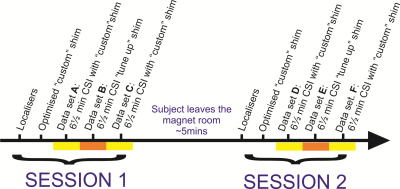 |
 Reproducibility of cardiac 31P MRS at 7 T Reproducibility of cardiac 31P MRS at 7 T
Jane Ellis, Ladislav Valkovic, Lucian Purvis, William Clarke, Christopher Rodgers
Cardiac PCr/ATP ratios measured by 31P MRS change in cardiovascular disease giving them value as a biomarker. We scanned 13 healthy volunteers at 7T, assessing their PCr/ATP with 6 ½ min 31P CSI scans. These data have better reproducibility than a 30min 3T protocol previously published by our centre. Repeated PCr/ATP measurements from subjects in this study were not significantly (P=0.83) different. Measurements were significantly different (P<0.001) from DCM patient data acquired in a previous 7T study using the same coil and pulse sequence. This data will allow us to plan future 7T 31P-MRS clinical studies.
|
17:03
|
0622.
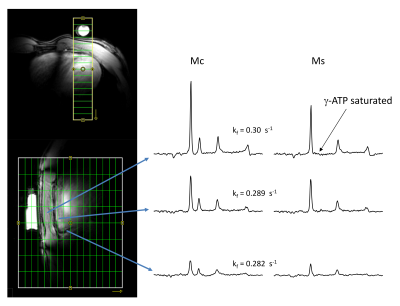 |
 Creatine Kinase Rate Constant in the Human Heart at 7T: A Novel Superfast Magnetization Saturation Transfer Method Creatine Kinase Rate Constant in the Human Heart at 7T: A Novel Superfast Magnetization Saturation Transfer Method
Adil Bashir, Jianyi Zhang, Nouha Salibi, Ronald Beyers, Thomas Denney
Changes in Creatine Kinase (CK) system are observed in heart failure and measurement of CK reaction rate constant (kf) can be useful to monitor pathology. 7T MR scanner offers improved signal to noise and spectral resolution and has potential for robust measurements. In this study we demonstrate novel superfast saturation transfer method (T1nom – method) to measure ATP production rate via CK forward reaction in human hearts at 7T. Spatial localization was achieved by GOIA-1D-ISIS/2D-CSI approach. Our measured kf values were consistent with literature.
|
17:15
|
0623.
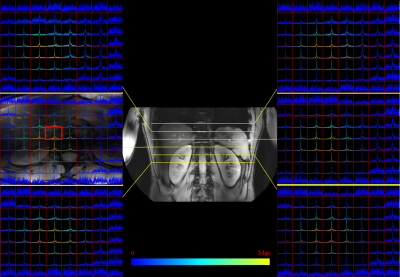 |
 Large FOV phosphor MR Spectroscopic imaging with multi-transmit proton MR imaging in the liver at 7 Tesla Large FOV phosphor MR Spectroscopic imaging with multi-transmit proton MR imaging in the liver at 7 Tesla
Quincy van Houtum, Dimitri Welting, Mark Gosselink, Christopher Rodgers, Wybe van der Kemp, Dennis Klomp
We combined 1H MRI and 31P MRSI in the liver by integrating a 31P RF body coil in a 7T MR system with a 16 channel 31P receive array merged with 1H fractionated dipole antennas The setup facilitates uniform 31P excitation by the body coil with high sensitivity from the receiver array, while providing B1 shimmed proton imaging with a dipole array.
|
17:27
 |
0624.
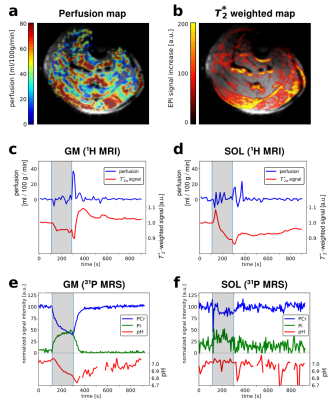 |
 Dynamic perfusion and T2*-weighted 1H MRI interleaved with multivoxel 31P MRS of exercising human calf at 7T Dynamic perfusion and T2*-weighted 1H MRI interleaved with multivoxel 31P MRS of exercising human calf at 7T
Fabian Niess, Albrecht Schmid, Georg Fiedler, Roberta Frass, Wolfgang Bogner, Alfredo Lopez Kolkovsky, Pierre Carlier, Ewald Moser, Martin Meyerspeer
To quantify perfusion and high-energy metabolite time courses of exercising gastrocnemius and soleus muscles in one time-resolved acquisition, 1H arterial spin labeling with multislice EPI was interleaved with multivoxel semi-LASER 31P-MRS. Perfusion mapping and T2* weighted MRI yielded reasonable time courses and were less sensitive to motion, compared to single slice acquisitions. Spectroscopic time courses of phosphocreatine, inorganic phosphate and pH with fitted PCr recovery time constants were consistent with literature in both GM and SOL. A significant 31P SNR increase was found when the VOI perceived adiabatic 1H inversion which can be explained by NOE.
|
17:39
 |
0625.
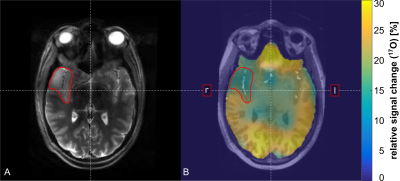 |
 Metabolic Rate of Oxygen Consumption in Brain Tumors: A Pilot 17O-MRI Study Metabolic Rate of Oxygen Consumption in Brain Tumors: A Pilot 17O-MRI Study
Sebastian Niesporek, Armin Nagel, Reiner Umathum, Nicolas Behl, Mark Ladd, Heinz-Peter Schlemmer, Daniel Paech
The cerebral metabolic rate of oxygen (CMRO2) is an interesting biomarker and can be used as a diagnostic parameter in various neurodegenerative diseases or tumors. A dynamic 17O MRI inhalation method was optimized for application in a clinical setting and employed in two patient examinations to investigate CMRO2 in human brain tumors as part of an ongoing pilot study. In tumor tissue, a decrease in oxygen consumption was detected, which is in consistent with the Warburg effect. To our knowledge, the presented work includes the first patient study with dynamic 17O MRI.
|
17:51
|
0626.
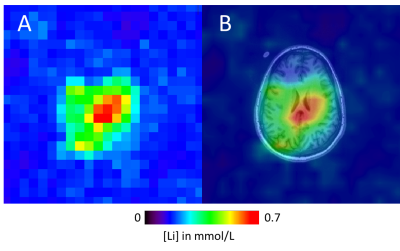 |
 In vivo investigation of lithium brain distribution in bipolar patients using 7Li MRI In vivo investigation of lithium brain distribution in bipolar patients using 7Li MRI
Jacques Stout, Arthur Coste, Franz Hozer, Franck Mauconduit, Sandro Romanzetti, Edouard Duchesnay, Cécile Lerman, Josselin Houenou, Frank Bellivier, Fawzi Boumezbeur
As an effective but poorly understood treatment for the prevalent bipolar disorder, studies focused on investigating the cerebral distribution of lithium are of important clinical interest. Here, we report our preliminary results obtained from 5 euthymic bipolar patients using 7Li MRI at 7T. Using a 3D SSFP sequence with ultra-short TE and Twisted Projection Imaging k-space sampling, we can confirm the heterogeneity of lithium brain distribution, as demonstrated by the individual and average concentration values in seven large regions-of-interest.
|
18:03
|
0627.
 |
 Dynamic 23Na-Imaging of the Human Lung with Fully Flexible Intrinsic Respiratory Gating Dynamic 23Na-Imaging of the Human Lung with Fully Flexible Intrinsic Respiratory Gating
Nicolas Behl, Armin Nagel, Reiner Umathum, Florian Maier, Mark Ladd, Mark Wielpütz, Hans-Ulrich Kauczor, Tanja Platt
23Na lung MRI is a potential tool e.g. for investigating tumor viability and treatment response. The acquired data is, however, influenced by respiratory motion since breath-hold acquisitions are not possible due to the long measurement times. Here, we present a method for full flexibility in retrospective gating of 3D-radial data, combined with a Compressed-Sensing reconstruction. Up to 14 frames could be reconstructed from one in-vivo dataset, corresponding to a temporal resolution of 0.27 s. The temporal resolution of 23Na lung MRI could potentially lead to a more accurate quantification of the Tissue Sodium Concentration in the human torso.
|
|













